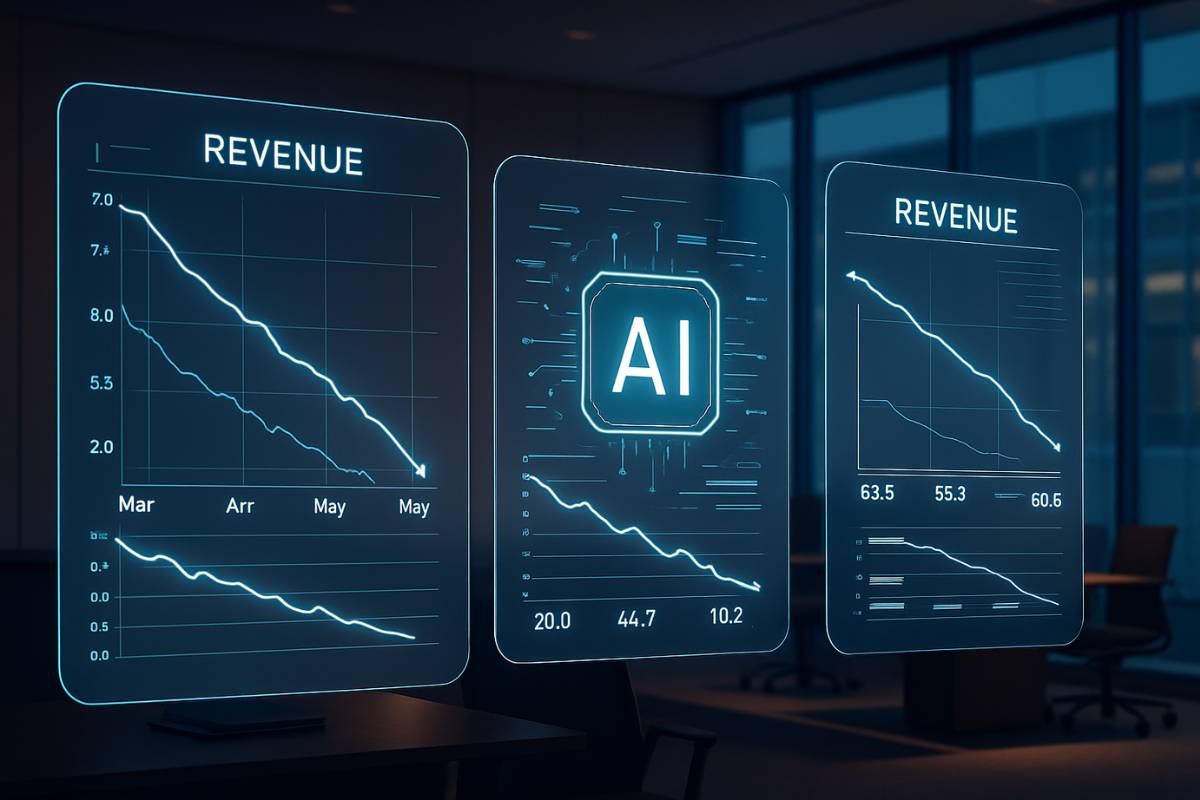Artificial intelligence is going to change the way IT services work around the world. Jefferies has released a new report that says the industry could lose 20% of its revenue between 2025 and 2030. This would be a huge change that would force companies to rethink their strategies and business models.
This isn’t just another tech fad. It’s a complete change in how IT services work, and it will have effects on consulting firms, outsourcing companies, and business clients all over the world.
Three Things That Are Causing the Drop in Revenue
The deflation won’t happen right away, but three important things are already making it possible for this big change to happen.
The most common reason is fear of investing. Companies are less and less willing to spend money on new IT because they are afraid that AI will move too quickly and make their investments useless before they see a return. It’s a classic case of tech anxiety: businesses don’t want to spend money on systems that might be out of date in a few months.
Gains in productivity can be good and bad at the same time. AI promises to make consulting, application services, infrastructure services, and business process outsourcing 5–35% more efficient. However, these same gains will make traditional IT services less necessary by about one-fifth during the forecast period.
Things that weren’t finished during past spending sprees make things even more complicated. Clients haven’t fully realized returns on about $280 billion in technology investments made each year from 2021 to 2024. This is more than twice the $130 billion average from 2016 to 2020. Companies are being more careful about making new commitments because of this investment hangover.
High-Margin Services Will Be Hit the Hardest
Not all IT services will be affected in the same way. Application managed services and business process outsourcing are especially at risk because AI automation is most likely to target these high-margin areas.
The report says that application services and BPOs will see bigger increases in productivity than consulting and infrastructure services. This means that businesses that have built their business models around these high-end products may need to change course more quickly than others.
On the other hand, changes in consulting and infrastructure services might happen more slowly, which could give these areas more time to change their strategies and find new ways to add value.
Projections for Industry Growth Show a Sad Picture
The numbers don’t lie: the growth of IT services as a whole is likely to slow down a lot. Jefferies says that the sector will only grow by 1.5% to 3% each year from 2024 to 2029, which is a big change from the double-digit growth the industry saw in the past.
There are two opposing forces at work in this slowdown. Non-AI-related IT services will probably grow by 1–3% each year, but AI automation will cause existing services to lose 20% of their revenue, which will lead to a 1–3% decline each year. What does this mean? Overall growth is slow and barely keeps up with inflation.
This is a big change in how people think about and plan for business in an industry that is used to strong growth.
Mid-Sized Companies Face More Risk but Better Opportunities
The report says that mid-sized IT companies are in a strange situation. They are at greater risk from AI-driven revenue deflation than their larger competitors, but they are also better able to achieve better growth.
The reason is that they are flexible and have a chance to grow their market share. Smaller businesses can change direction more quickly, adopt new technologies more quickly, and may even gain market share. Larger businesses, on the other hand, have to deal with old systems and organizational inertia.
This change could change the way companies compete, with quick-moving mid-sized companies taking on established industry giants that may be slower to change.
Jefferies Cuts IT Stock Targets
The brokerage firm’s worries about AI disruption have led to quick action in the stock markets. Jefferies has lowered its target prices for most of India’s major IT companies. It has cut its estimates for revenue and earnings per share by up to 5% and its target prices by up to 10%.
The target price for TCS was cut from Rs 3,480 to Rs 3,230, but the Hold rating stayed the same. Infosys’s price target went down from Rs 1,860 to Rs 1,750, but the company still said to buy. Wipro, HCLTech, and Tech Mahindra also saw similar drops.
The company’s analyst said that Infosys and HCLTech are less likely to be hurt by falling sales than Tech Mahindra and Wipro. They also said they prefer Coforge and Hexaware over Tech Mahindra and Wipro.
The Timing of AI’s Effects Makes It Hard to Plan Ahead
The timing mismatch between AI’s deflationary effects and its growth opportunities is probably the most worrying thing for business leaders. The report says that “AI-led revenue deflation is likely to affect growth in FY27 because revenue deflation from AI may happen earlier and any new spending driven by AI is likely to happen later.”
This means that businesses will have to deal with lower traditional revenues before they can fully take advantage of new AI-driven business opportunities. This is a classic “valley of death” situation that will put the financial strength and strategic planning of IT services companies to the test.
The time between a disruption and the creation of new opportunities could make it hard for some businesses to decide what to do with their employees, infrastructure, and market position during the transition period.
A Wider Look at Business Technology Spending
There are bigger changes going on in how businesses spend money on technology that are causing the deflation of IT services. Global IT spending is expected to rise by 9.3% to $5.74 trillion by 2025. However, the way this money is being spent is changing a lot.
Globally, IT services are expected to grow by 9.4%, and spending on software is expected to grow by 14%. These overall numbers, on the other hand, hide the real problems that AI is causing in certain service areas.
Companies are moving past the initial excitement about AI and are now looking for ways to use it that fit with their long-term goals. This more careful approach means that investments will be focused on using AI and automation to boost worker productivity and give the company a competitive edge.
What It Means for Jobs and Skills
The drop in revenue isn’t just bad for businesses; it also has big effects on jobs. Jefferies’ earlier research has shown that AI will have the biggest effect on entry-level jobs. For example, the unemployment rate for recent college graduates is already 5.8%, which is higher than the national average of 4%.
The company’s earlier reports said that AI could take over as many as 50% of entry-level white-collar jobs in the next one to five years. Areas like sales, customer support, software development, and marketing, which are usually good places for junior IT professionals to work, are especially at risk.
This disruption in the job market makes things even harder for IT services companies, which have to deal with both revenue pressures and the challenges of changing their workforce.
Plans for the Future and How to Respond Strategically
The report says that AI-driven spending may speed up in the long term, even though the short-term pressure on legacy revenues is hurting valuations. Because of this, companies must carefully plan the transition.
There are a few things that will probably affect how well you do:
- How quickly can you retrain workers for AI-augmented jobs
- How quickly can you create new AI-powered services?
- How financially strong are you to get through the revenue transition period
Companies that can handle this change well may come out stronger, while those that can’t may be forced to offer lower-margin, commoditized services.
The 20% drop in revenue projection is more than just a financial problem; it’s a test of the IT services industry’s ability to adapt to a world driven by AI. What companies do in the next five years will not only determine whether they survive, but also whether they can do well in the world after AI changes it.
















